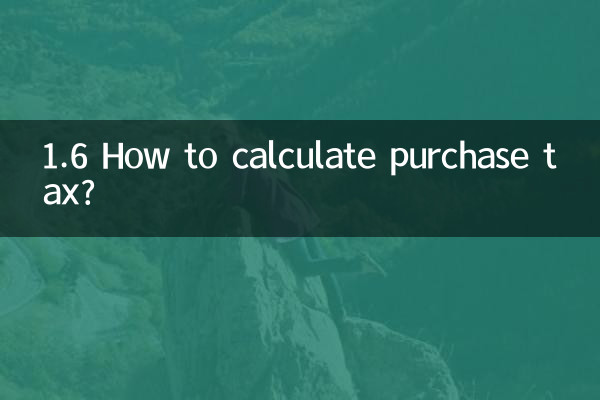1.6 How to calculate purchase tax?
Recently, the calculation method of purchase tax for passenger cars with a displacement of 1.6 liters and below has become a hot topic. As the automobile consumer market picks up, many consumers are concerned about the specific calculation methods and preferential policies of purchase tax. This article will provide you with a detailed analysis of the calculation method of 1.6 purchase tax and provide structured data to help you quickly grasp key information.
1. Basic calculation method of purchase tax

According to the Vehicle Purchase Tax Law of the People's Republic of China, the vehicle purchase tax rate is 10%. Passenger cars with a displacement of 1.6 liters and below may enjoy preferential policies in some regions or periods, but the specifics are subject to local policies. The calculation formula for purchase tax is as follows:
| Project | Calculation formula |
|---|---|
| purchase tax | Vehicle invoice price ÷ (1 + value-added tax rate 13%) × purchase tax rate 10% |
For example, for a 1.6-liter vehicle with an invoice price of 150,000 yuan, the purchase tax is calculated as follows:
| Invoice price | Price after excluding VAT | purchase tax |
|---|---|---|
| 150,000 yuan | 15 ÷ 1.13 ≈ 132,700 yuan | 13.27 × 10% ≈ 13,300 yuan |
2. Preferential policies and precautions
In recent years, the state has implemented a halving purchase tax policy (i.e. a tax rate of 5%) for passenger cars with an engine capacity of 1.6 liters and below, but it is necessary to pay attention to whether the policy is still being implemented. The following is a summary of the purchase tax preferential policies in recent years:
| time period | Preferential policies | Scope of application |
|---|---|---|
| 2015-2016 | Tax rate 5% (halved) | Displacement 1.6 liters and below |
| 2017-2018 | Tax rate 7.5% (partial reduction) | Displacement 1.6 liters and below |
| 2023 | Please check local policies | Subject to official notification |
3. Frequently Asked Questions
1.Is the purchase tax calculated based on the guide price?
The purchase tax is based on the actual invoice price, not the manufacturer's guide price. If the invoice price is lower than the price approved by the tax system, the price will be calculated based on the approved price.
2.Are new energy vehicles exempt from purchase tax?
According to the 2023 policy, new energy vehicles (pure electric, plug-in hybrid, etc.) still enjoy the purchase tax exemption, but 1.6-liter fuel vehicles are not included in this.
3.Do I need to pay purchase tax on used cars?
There is no need to pay purchase tax repeatedly for second-hand car transactions, it is only levied on first registration.
4. Summary and suggestions
The purchase tax calculation for a 1.6-liter vehicle needs to be calculated based on the invoice price and the current tax rate. It is recommended to confirm the cost through the following steps before purchasing the vehicle:
1. Ask the dealer for the vehicle invoice price;
2. Check whether the local area enjoys preferential purchase tax policies;
3. Calculate specific amounts using formulas or online calculation tools.
Purchase tax is an important part of the cost of purchasing a car, and reasonable planning can save consumers money. For the latest policy details, you can visit the official website of the State Administration of Taxation or consult the local vehicle management office.

check the details

check the details